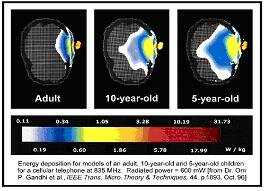Studies relating to children
The studies below indicate a range of increased risks associated with children's exposure to EMF's. (Click on the study for more details):
Need help understanding the studies?...
Glossary...
Studies on brain tumours
Found a 5-fold increase in glioma risk for those starting mobile phone use under 20 years of age indicating the age group at first use is highly significant.
Studies relating to absorption of radiation into the head of a child
Alvaro A. de Salles a; Giovani Bulla a; Claudio E. Fernaacutendez Rodriguez, Electrical Engineering Department, Federal Universityof Rio Grande do Sul (UFRGS), Porto Alegre, Brasil. Electromagnetic Absorption in the Head of Adults and Children Due to Mobile Phone Operation Close to the Head
The Specific Absorption Rate (SAR) produced by mobile phones in the head of adults and children is simulated using an algorithm based on the Finite Difference Time Domain (FDTD) method. Realistic models of the child and adult head are used. The electromagnetic parameters are fitted to these models. Comparison also are made with the SAR calculated in the children model when using adult human electromagnetic parameters values. Microstrip (or patch) antennas and quarter wavelength monopole antennas are used in the simulations. The frequencies used to feed the antennas are 1850 MHz and 850 MHz. The SAR results are compared with the available international recommendations.
It is shown that under similar conditions, the 1g-SAR calculated for children is higher than that for the adults. When using the 10-year old child model, SAR values higher than 60% than those for adults are obtained.

Studies relating to children's exposure to chronic low level electro-magnetic radiation (phone masts, wi-fi etc)
This paper presents the results of experiments on school children living in the area of the Skrunda Radio Location Station (RLS) in Latvia. Motor function, memory and attention significantly differed between the exposed and control groups. Children living in front of the RLS had less developed memory and attention, their reaction time was slower and their neuromuscular apparatus endurance was decreased.
The signals from this transmitter were pulsed and of a similar intensity to that which children exposed to Wi-Fi would be subjected to.
See also laboratory studies...
Studies relating to effects on fetus of cell phone use in pregnancy
Mothers were recruited to the Danish National Birth Cohort early in pregnancy. When the children of those pregnancies reached 7 years of age in 2005 and 2006, mothers were asked to complete a questionnaire regarding the current health and behavioral status of children, as well as past exposure to cell phone use. Mothers evaluated the child's behavior problems using the Strength and Difficulties Questionnaire. Greater odds ratios for behavioral problems were observed for children who had possible prenatal or postnatal exposure to cell phone use. After adjustment for potential confounders, the odds ratio for a higher overall behavioral problems score was 1.80 (95% confidence interval = 1.45-2.23) in children with both prenatal and postnatal exposure to cell phones.
Author's conclusions: Exposure to cell phones prenatally-and, to a lesser degree, postnatally-was associated with behavioral difficulties such as emotional and hyperactivity problems around the age of school entry. These associations may be noncausal and may be due to unmeasured confounding. If real, they would be of public health concern given the widespread use of this technology.
|



